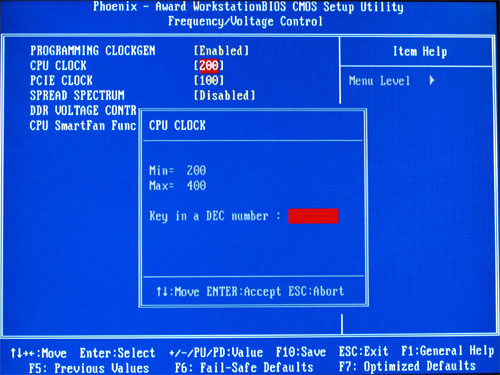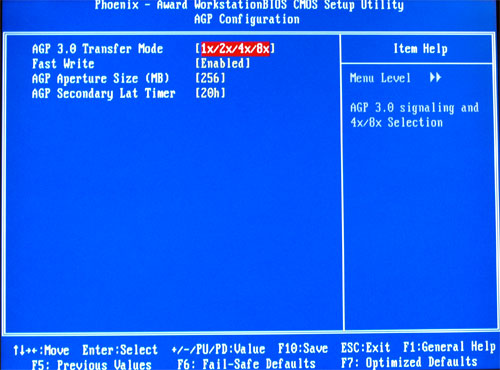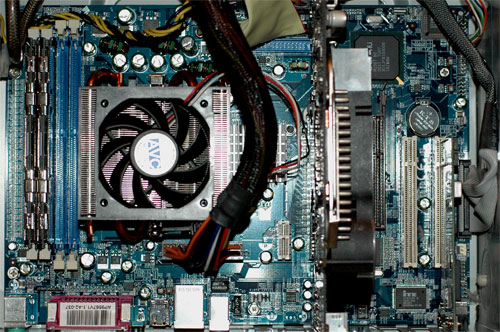FIRST LOOK: ULi M1695 PCIe/AGP Socket 939 for Athlon 64
by Wesley Fink on July 13, 2005 12:05 AM EST- Posted in
- Motherboards
Basic Features: ULi AP9507A (M1695/M1567)
| ULi AP9507A (M1695/M1567) | |
| CPU Interface | Socket 939 Athlon 64 |
| Chipset | ULi M1695 Northbridge - ULi M1567 Southbridge |
| BUS Speeds | 200MHz to 400MHz in 1MHz Increments |
| PCIe Speeds | 75-125MHz in 1MHz Increments |
| PCI/AGP | Fixed at 33/66 |
| Core Voltage | Startup, 0.825V to 1.55V in 0.025V increments |
| CPU Clock Multiplier | Startup, 4x-25x in 1X increments |
| HyperTransport Frequency | 1000MHz (1GHz) |
| HyperTransport Multiplier | 200, 400, 600, 800, 1000 |
| DRAM Voltage | NO Adjustments |
| HyperTransport Voltage | NO Adjustments |
| Memory Slots | Four 184-pin DDR DIMM Slots Dual-Channel Configuration Regular Unbuffered Memory to 4GB Total |
| Expansion Slots | 1 PCIe x16 (or 2 PCIe x8) 1 AGP 8X 2 PCIe x1 2 PCI Slots |
| Onboard SATA/RAID | 2 SATA Drives by ULi M1567 (RAID 0, 1, JBOD) |
| Onboard IDE/IDE RAID | Two Standard ATA133/100/66 (4 drives) |
| Onboard USB 2.0/IEEE-1394 | 8 USB 2.0 ports supported by ULi M1567 No Firewire (Optional) |
| Onboard LAN | 10/100 Ethernet by Realtek PNY (Gigabit LAN Optional) |
| Onboard Audio | AC '97 2.3 6-Channel by Realtek ALC655 |
| BIOS Revision | Award OC50624A (6/24/2005) |
The ULi Award BIOS provides a wide range of BIOS control options, particularly considering that this is a Reference Board used to qualify a chipset. The wide 200 to 400 range for CPU clock was a pleasant surprise, but it is somewhat academic with no memory voltage controls present in the BIOS.

The included vCore adjustments and PCIe speed adjustments were also a nice addition, although the range to just 1.55V is very limited for Clawhammer processors, which are 1.50V at default.

Since the ULi implementation of AGP is real AGP and not derived, the AGP adjustments will look familiar to AGP owners.
Reference Boards are designed for qualification and not for production. It would therefore be a mistake to dwell on the Reference Board layout, except to say that Reference Boards often influence layout of production boards. IDE, SATA, video slots and bottom edge headers all work fine where they are located. However, we hope that production boards will take a different approach to the location of the 24-pin ATX power connector. Located in about the center of the board between the CPU and rear IO ports, there is really no good way to route the heavy cable. In the center of the board, you have to be careful not to interfere with air flow or operation of the CPU and memory.
The location of the floppy connector at the bottom of the board will be a long reach for floppy users. Many buyers don't care about floppies any more, but if you still use them, the bottom of the board is an inconvenient and hard-to-reach location.











72 Comments
View All Comments
Sabresiberian - Wednesday, July 13, 2005 - link
Dang! I just bought an AGP mainboard! LOL! Well, I probably saved $100 and money was a concern for me.Glad to see this come out still, hats off to ULI :)
Wish it had come out 6 months or more ago, I think that would have been more timely, but better late than never, heh.
nserra - Wednesday, July 13, 2005 - link
#Wesley FinkRepeating....
I noted that the speed of the AGP is very good, but vs the older 1689 is it equal, higher or is the 1689 even higher. Can you do some 939A8X-M test just to check?
Also your explanation to #20 is confusing (at least to me), isn’t HT (200x5) = 1000HT speed and the chipset can do 400 (2,3,4X400) ?
#28 I think Uli chipsets as been always one of the faster with hard disk transfers (a lot faster), the older don’t this I don’t know, also I don’t know the CPU % hit.
QV - Wednesday, July 13, 2005 - link
This looks like an interesting board. When I found out that K8T890 doesn't support dual-core, I figured my next machine would be nF4, but this looks good enough that by the time I build my next machine (which will probably be months away, for money reasons), I may very well use a board based on this chipset.Also, speaking of dual AGP/PCI-E solutions, can't the VIA PT880 Pro do the same? I know it's for a different platform, but it doesn't seem to be a hack like some boards seem to use, and ASRock makes one or two boards based on it. What's the story there? Can the PT880 Pro really also do the triple graphics interface, and platform differences aside, how does it stack up against the M1695?
L3p3rM355i4h - Wednesday, July 13, 2005 - link
Interesting. Hopefully it doesn't go the way of the KT890.MarkHark - Wednesday, July 13, 2005 - link
Does anybody know if this ULI south bridge supports NCQ and how its hard drive I/O performance compares to Nforce4 and SIS?smn198 - Wednesday, July 13, 2005 - link
#25 If I was after AGP with the possibility to upgrade to PCIe without changing motherboard then yes I would be interested but I doubt that this feature will interest OEMs. The cost of a full motherboard will be pushed up once features such as SATA2 and Gbit LAN are added. The possibility of two full x16 PCIe slots is the most interesting thing to me as it could add a bit of future proofing.I would be interested if it had been out a few months and I wasn't going to be an early adopter. I'd want to know what the drivers are like and no matter how good this chipset is, I doubt it's driver support will be as good as the nVidia. Good luck to them though! We need another high-end chipset maker for AMD.
Zebo - Wednesday, July 13, 2005 - link
Abit and Gigabyte both have full-blown boards in the works.----------------
Well that certainly makes things interesting.. Thanks again.. And I take back my comment about DOA like SIS 75x seems to be:)
Wesley Fink - Wednesday, July 13, 2005 - link
#25 - Competitive and much cheaper also works - with the unique AGP on PCIe to get your attention.smn198 - Wednesday, July 13, 2005 - link
#15 - I agree but also, they don't need to show that they are as competitive as the nForce4, they need to be better.fishy - Wednesday, July 13, 2005 - link
Exciting news to me:
_I still have an 'ol Asus/ Ali motherboard
running, and it has been "very good to me" :)
_I'm still looking for a AMD 64 motherboard
(bought an NF4 board a few months ago
and got rid of it really fast, too many
problems)
Asus, get on this fast, please!